Accelerate > Publications
Search this online library featuring the latest FAO publications, issue papers and briefs which offer up-to-date knowledge and innovative insights for SDG acceleration.
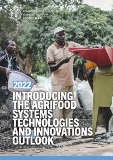
Introducing the Agrifood Systems Technologies and Innovations Outlook
2022
Agrifood system transformation to achieve the Sustainable Development Goals requires increased attention to developing, adapting and diffusing impactful science, technology and innovation (STI). Current levels and patterns of STI uptake are inadequate to facilitate needed agrifood system transformations, especially in today's low- and middle-income countries
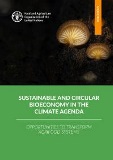
Sustainable and circular bioeconomy in the climate agenda: Opportunities to transform agrifood systems
2022
The bioeconomy offers opportunities to reduce greenhouse gas (GHG) emissions along the agrifood system by replacing fossil-based resources and processes with biological ones, from microbiome innovations, biofertilizers and biopesticides, to alternative proteins, bio-based plastics and textiles, and biological waste management, to name just a few. A sustainable and circular bioeconomy also presents opportunities to improve climate change adaptation and resilience,...

Transforming public agricultural extension and advisory service systems in smallholder farming - Status quo, gaps, way forward
2022
Worldwide, extension and advisory service (EAS) systems have undergone reforms since the 1990s. However, the reforms of the last two decades in many countries have largely failed, as there has not been significant increase in accountability, efficiency, empowerment or impact. To fill this gap, this document, based on a systematic and extended literature review, delves into public EAS systems in developing countries, with a special focus on smallholder farming and institutional reforms.
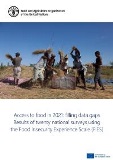
Access to food in 2021: filling data gaps - Results of twenty national surveys using the Food Insecurity Experience Scale (FIES)
2022
This report presents the results of assessments based on the food insecurity experience scale (FIES), data collected by FAO in twenty least developed countries (LDCs), landlocked developing countries (LLDCs) and Small Island Developing States (SIDS) between November 2021 and February 2022. For nine of the countries (including eight SIDS), it was the first time FIES data had been collected.

Urban and peri-urban agriculture sourcebook - From production to food systems
2022
The purpose of this book is to set out the key lessons learned and to provide recommendations and guidance based on existing cases and examples for a wide range of actors involved in urban food systems. In particular, the aim is for this publication to serve as a sourcebook for local decision-makers, policy advisors, urban planners, specialists, practitioners and others involved in urban and peri-urban agriculture (UPA).

A rapid review of effective financing for policy, implementation and partnerships addressing drought risks
2022
The report presents an overview of current knowledge and thinking concerning the effectiveness of three distinct layers of financing that set out to address drought risks in different ways. For each of these, results are conceptualized and measured in different ways for disaster risk reduction, adaptation to climate change, and transformative green finance.
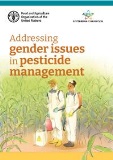
Addressing gender issues in pesticide management
2022
The Rotterdam Convention Secretariat (NSPRD) and the Gender team in ESP developed this publication with the objective of highlighting the gender-related implication of pesticide use and management, focusing on the role of women in handling hazardous pesticides in agriculture, the reasons why they are at higher risk and the health-related implications they face. The brochure provides an overview of how FAO addresses the topic ...

Labelling and certification schemes for Indigenous Peoples' foods
2022
This review, for the first time to date, analyses the potential of labelling and certification schemes for Indigenous Peoples to market their food products. Specifically, it looks at those schemes that are designed by, with and for Indigenous Peoples, and that can provide economic, social and environmental benefits while protecting and promoting their unique values centered around the respect of life and Mother Earth.
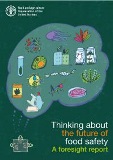
Thinking about the future of food safety -A foresight report
2022
In this publication, the FAO Food Safety Foresight programme provides an overview of the major global drivers and trends by describing their implications for food safety in particular and for agrifood systems by extrapolation. The various drivers and trends reported include climate change, changing consumer behaviour and preferences, new food sources and production systems, technological advances, microbiome, circular economy, food fraud, among others.
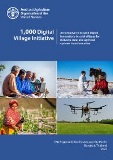
1,000 Digital Village Initiative - An initiative to expand digital innovations in rural villages for inclusive rural and agrifood systems transformation
2022
This report introduces the FAO Digital Village Initiative, which aims to facilitate through knowledge and information. It approaches countries and communities to develop, accelerate and deploy digital technologies in rural villages and communities. The report introduces the Digital Village Ecosystem approach. It describes an instrument (tool) to gather information and provide a village ecosystem assessment to help generate recommendations for future interventions to deploy beneficial, ...

Soils for nutrition: state of the art
2022
This booklet contributes to understanding processes related to soil fertility from the perspectives of food production and food security, and the environmental and climate change impacts associated with fertilizer misuse and overuse. The booklet also outlines the main areas of opportunity and the way forward to solve the nutrient imbalance prevailing in our current agrifood systems.

South-South in Action - South-South and triangular cooperation in agricultural development: FAO's experiences
2022
This publication outlines key features of South-South and Triangular Cooperation (SSTC) and how FAO has applied SSTC to the delivery of its mission. The case studies presented provide a window on how SSTC has contributed to alleviating hunger and malnutrition in countries across the global South and has helped build resilience in the face of climate change and other development challenges.
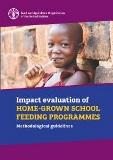
Impact evaluation of home-grown school feeding programmes: Methodological guidelines
2022
This publication seeks to support practitioners by providing methodological guidelines for conducting rigorous impact assessments of Home Grown School Feeding (HGSF) programmes. It presents an overview of the main technical issues to be addressed depending on the characteristics of the context and of the intervention itself.
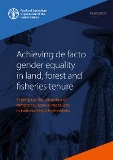
Achieving de facto gender equality in land, forest and fisheries tenure - Scaling up the adoption of temporary special measures in national legal frameworks
2022
This legal paper first considers the obligations of states in relation to gender equality and the adoption of temporary special measures, and the work of the Convention on the Elimination of All Forms of Discrimination Against Women (CEDAW) Committee in clarifying and expanding the concept of temporary special measures.

Small-scale producers in sustainable agrifood systems transformation
2022
This paper analyzes the diversity of small-scale producers and demonstrates how understanding small-scale production can have consequences for how policies and investments are directed and how they impact small-scale producer livelihoods. The diverse roles and functions of small-scale production are presented as being essential to realizing sustainable agrifood systems transformations and respecting its social, environmental and economic dimensions.
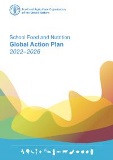
School Food and Nutrition – Global Action Plan 2022–2026
2022
The School food and nutrition - Global action plan seeks to consolidate and guide FAO’s synergistic efforts, setting out priority and concrete outputs to be achieved by 2026.

Sustainable and circular bioeconomy in the biodiversity agenda - Opportunities to conserve and restore biodiversity in agrifood systems through bioeconomy practices
2022
The sustainable management of biodiversity contributes to addressing food and nutrition security, enhancing resilience, and providing livelihoods to local and indigenous communities that can diversify their activities and generate income.
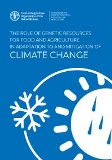
The role of genetic resources for food and agriculture in adaptation to and mitigation of climate change
2022
The main focus of this study is the state of current use of genetic resources in climate change adaptation and mitigation efforts. Each chapter explores the impacts of climate change on genetic resources and also considers the significance of genetic resources to climate change adaptation and mitigation.
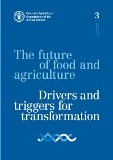
The future of food and agriculture – Drivers and triggers for transformation
2022
This report aims at inspiring strategic thinking and actions to transform agrifood systems towards a sustainable, resilient and inclusive future, by building on both previous reports in the same series as well as on a comprehensive corporate strategic foresight exercise that also nurtured FAO Strategic Framework 2022–31. It analyses major drivers of agrifood systems and explores how their trends could determine alternative futures of agrifood, socioeconomic and environmental systems.

FAO and the Sustainable Development Goals: Achieving the 2030 Agenda through empowerment of local communities
2022
The Sustainable Development Goals (SDGs) belong to all of us. But amid resurgent conflict, climate havoc, and social and health crises, we risk losing sight of them. Even so, they represent our best shot at a better future for people and planet. This publication shows how FAO and partners continue to work for the achievement of the SDGs, project by project, field by field, and country by country.
Browse by SDG
- SDG1: No Poverty
- SDG2: Zero Hunger
- SDG3: Good Health & Well-being
- SDG4: Quality Education
- SDG5: Gender Equality
- SDG6: Clean Water & Sanitation
- SDG7: Affordable and Clean Energy
- SDG8: Decent Work and Economic Growth
- SDG9: Industry, Innovation and Infrastructure
- SDG10: Reduced Inequalities
- SDG11: Sustainable Cities and Communities
- SDG12: Responsible Consumption and Production
- SDG13: Climate Action
- SDG14: Life Below Water
- SDG15: Life on Land
- SDG16: Peace, Justice and Strong Institutions
- SDG17: Partnerships for the Goals
Browse by Better
Browse by Priority Area
- Innovation for Sustainable Agriculture Production
- Blue Transformation
- One Health
- Small-Scale Producers' Equitable Access to Resources
- Digital Agriculture
- Healthy Diets for All
- Nutrition for the Most Vulnerable
- Safe Food for Everyone
- Reducing Food Loss and Waste
- Transparent Markets and Trade
- Climate Change Mitigating and Adapted Agrifood Systems
- Bioeconomy for Sustainable Food and Agriculture
- Biodiversity and Ecosystem Services for Food and Agriculture
- Achieving Sustainable Urban Food Systems
- Gender Equality and Rural Women's Empowerment
- Inclusive Rural Transformation
- Agriculture and Food Emergencies
- Resilient Agrifood Systems
- Hand-in-Hand Initiative
- Scaling up Investment
